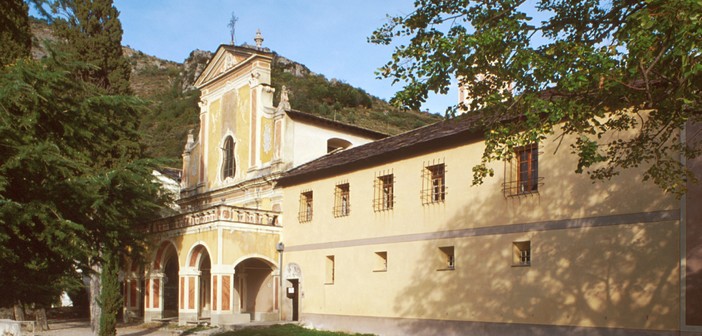Compared to other monasteries or abbeys, the one in Saorge is rather recent. This village, one of the strongholds of the Roya Valley, is a stronghold of the Savoy. Saorge controls the salt route between Nice and Piedmont. The Franciscan convent was founded in 1633.
Six years later, the commune of Saorge provided them with the chapel of Saint Bernard and granted them land to build a convent. The construction and arrangement of the church were completed at the end of the 17th century.
The cloister and the church were decorated between 1760 and 1762 by Caldéroni, a renowned artist of that period. This monastery, along with that of Cimiez, is a perfect example of Baroque architecture in our region. The cloister depicts the life of Saint Francis with 25 frescoes painted in the 18th century. The church, dedicated to Our Lady of Miracles, dates from the 17th century.
The sundials from 1760, adorned with zodiac signs, will surely catch one’s eye. The garden with its terraced vegetable garden and orchard is another curiosity of this monastery. The monks cultivated on the mountainside, taking advantage of good exposure and a microclimate favored by a bend in the Roya. In 1794, the French, having invaded the County of Nice supposedly to bring freedom, expelled the monks from Saorge. They only returned in 1824.
In the meantime, the buildings were assigned to the communal hospice. Saorge became French again in 1860 and thus underwent the anti-clerical laws of the Third Republic. The Franciscans were expelled and the monastery became a holiday camp. During the Second World War, the Italians used it as a barracks and were replaced by the Germans after the Italian capitulation.
The monastery was classified as a historic monument in 1917. Fifty years later, the State repurchased it, the Franciscans returned in 1969, and after about twenty years, they left it permanently.
Today, the Saorge monastery is an artist residence, a kind of Villa Medici where writers, poets, and musicians come to study, reflect, write, and compose in this setting preserved from the hustle and bustle of the world.
The old monastic enclosure is closed to visitors, thereby preserving the peace and contemplation of the resident artists. One must not forget the Romanesque bell tower of the Madonna Del Poggio, standing at the edge of Saorge, watching over this ancient salt route.
Thierry Jan


